Abstract
9-β-d-Arabinofuranosyladenine (ara-A) was deaminated to 9-β-d-arabinofuranosylhypoxanthine by adenosine deaminase present in fetal bovine serum, newborn calf serum, and calf serum used to supplement tissue culture media. Heating newborn calf serum or calf serum for 12 h at 56 C completely eliminated the enzymatic deamination of ara-A. The deaminase activity associated with fetal bovine serum was more refractory to heating, requiring 24 h for complete inactivation. The nutritive value of heat-inactivated calf serum did not differ significantly from that of unheated serum based on considerations of population doubling times, deoxyribonucleic acid synthesis, and relative cloning efficiencies of KB cells.
Full text
PDF
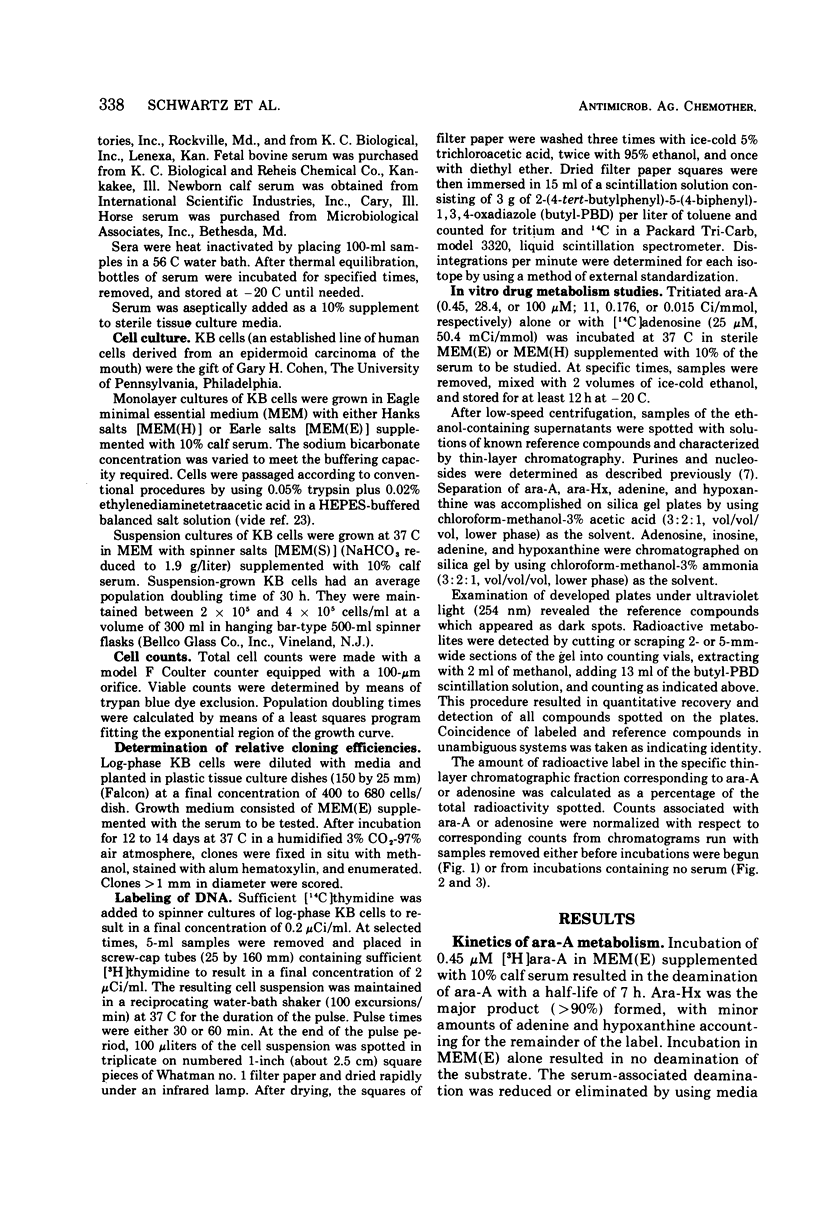

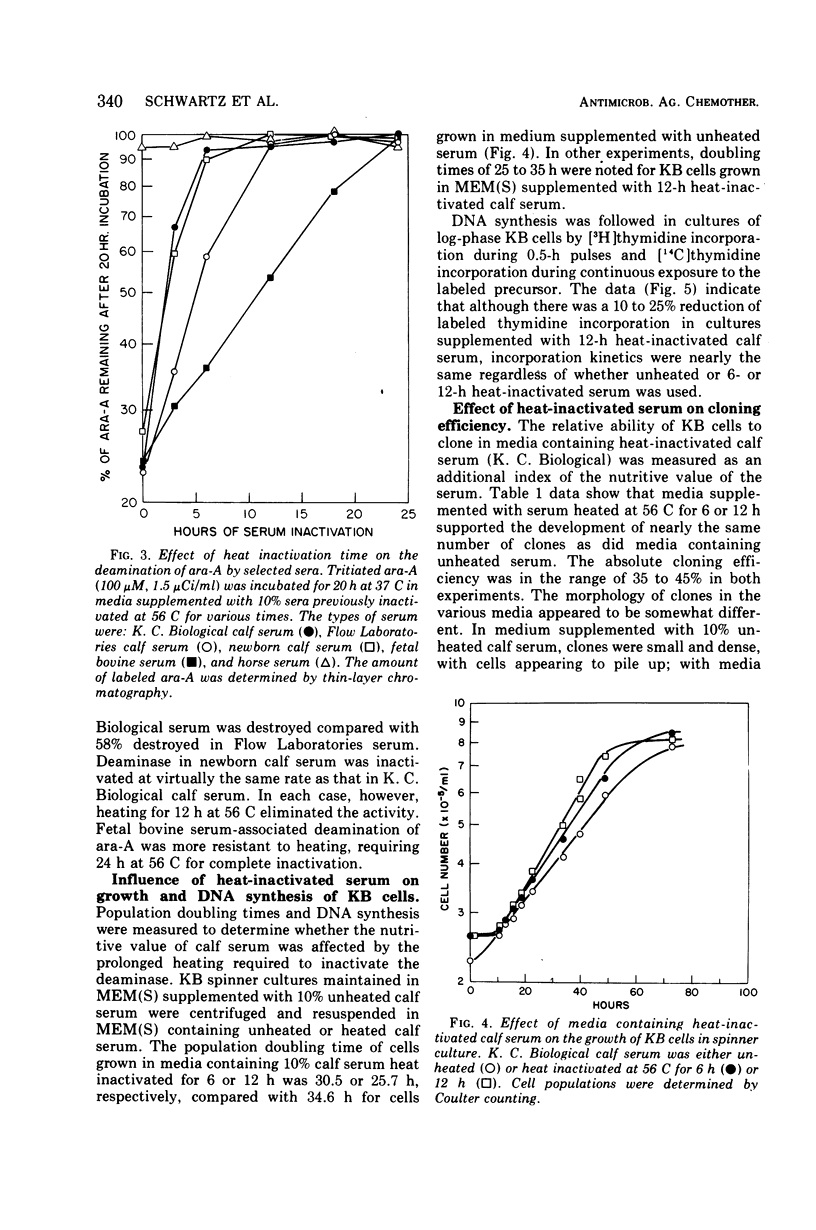
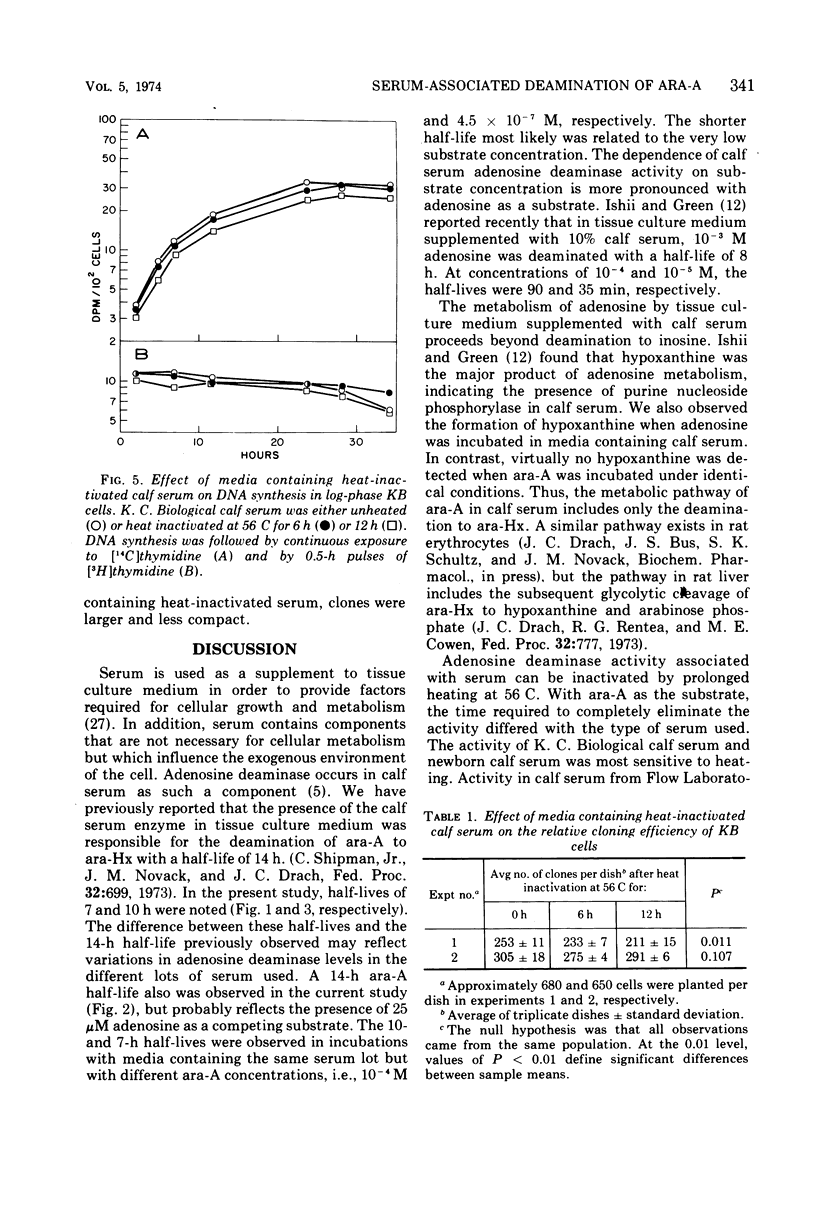
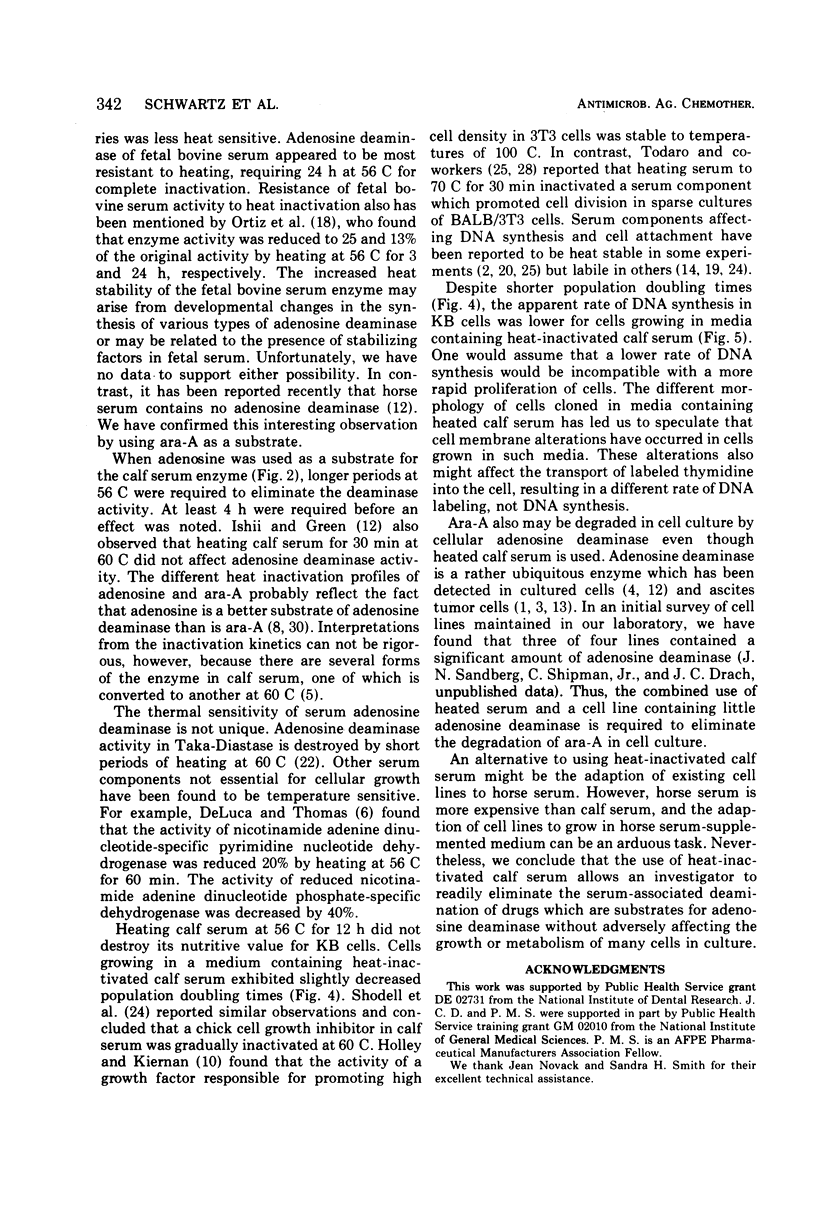
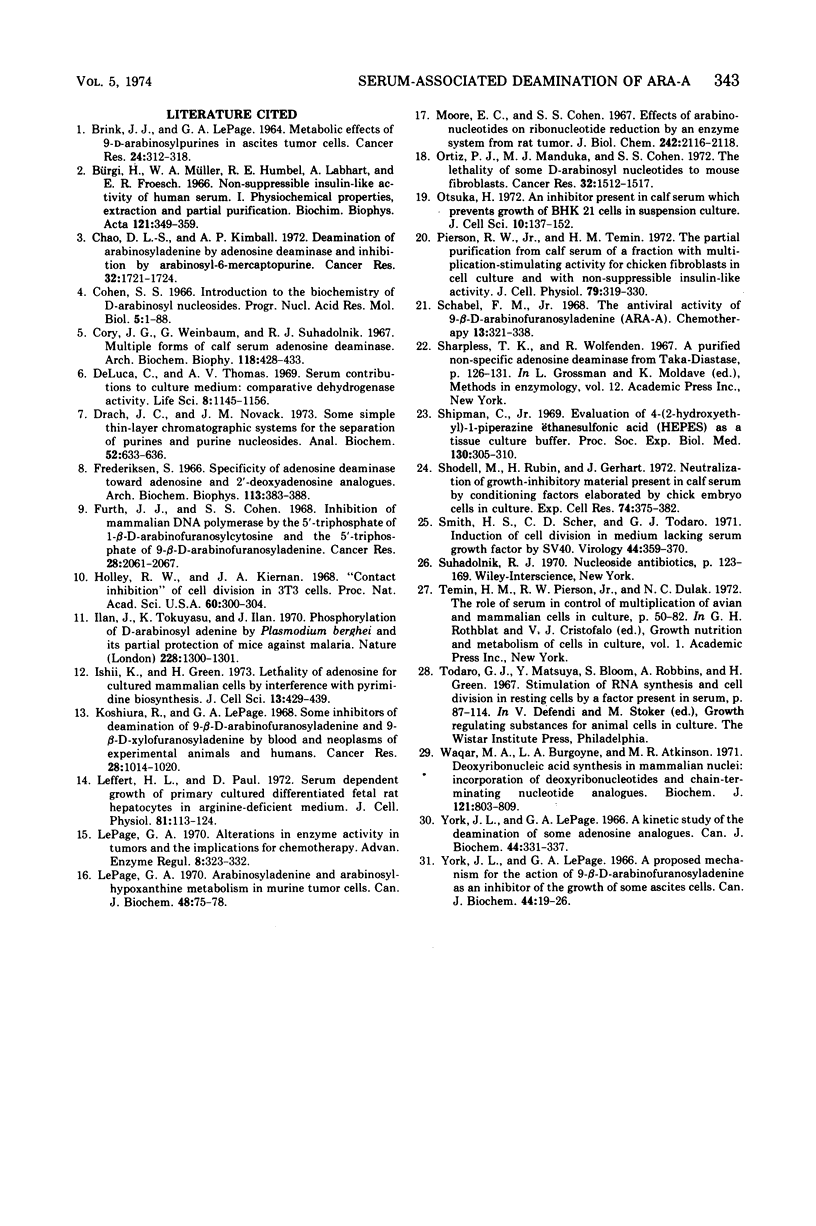
Selected References
These references are in PubMed. This may not be the complete list of references from this article.
- BRINK J. J., LEPAGE G. A. METABOLIC EFFECTS OF 9-D-ARABINOSYLPURINES IN ASCITES TUMOR CELLS. Cancer Res. 1964 Feb;24:312–318. [PubMed] [Google Scholar]
- Bürgi H., Müller W. A., Humbel R. E., Labhart A., Froesch E. R. Non-suppressible insulin-like activity of human serum. I. Physicochemical properties, extraction and partial purification. Biochim Biophys Acta. 1966 Jun 29;121(2):349–359. doi: 10.1016/0304-4165(66)90124-3. [DOI] [PubMed] [Google Scholar]
- Chao D. L., Kimball A. P. Deamination of arabinosyladenine by adenosine deaminase and inhibition by arabinosyl-6-mercaptopurine. Cancer Res. 1972 Aug;32(8):1721–1724. [PubMed] [Google Scholar]
- Cohen S. S. Introduction to the biochemistry of D-arabinosyl nucleosides. Prog Nucleic Acid Res Mol Biol. 1966;5:1–88. doi: 10.1016/s0079-6603(08)60231-7. [DOI] [PubMed] [Google Scholar]
- Cory J. G., Weinbaum G., Suhadolnik R. J. Multiple forms of calf serum adenosine deaminase. Arch Biochem Biophys. 1967 Feb;118(2):428–433. doi: 10.1016/0003-9861(67)90371-2. [DOI] [PubMed] [Google Scholar]
- De Luca C., Thomas A. V. Serum contributions to culture medium: comparative dehydrogenase activity. Life Sci. 1969 Nov 15;8(22):1145–1156. doi: 10.1016/0024-3205(69)90169-6. [DOI] [PubMed] [Google Scholar]
- Drach J. C., Novack J. M. Some simple thin-layer chromatographic systems for the separation of purines and purine nucleosides. Anal Biochem. 1973 Apr;52(2):633–636. doi: 10.1016/0003-2697(73)90071-7. [DOI] [PubMed] [Google Scholar]
- Frederiksen S. Specificity of adenosine deaminase toward adenosine and 2'-deoxyadenosine analogues. Arch Biochem Biophys. 1966 Feb;113(2):383–388. doi: 10.1016/0003-9861(66)90202-5. [DOI] [PubMed] [Google Scholar]
- Furth J. J., Cohen S. S. Inhibition of mammalian DNA polymerase by the 5'-triphosphate of 1-beta-d-arabinofuranosylcytosine and the 5'-triphosphate of 9-beta-d-arabinofuranoxyladenine. Cancer Res. 1968 Oct;28(10):2061–2067. [PubMed] [Google Scholar]
- Holley R. W., Kiernan J. A. "Contact inhibition" of cell division in 3T3 cells. Proc Natl Acad Sci U S A. 1968 May;60(1):300–304. doi: 10.1073/pnas.60.1.300. [DOI] [PMC free article] [PubMed] [Google Scholar]
- Ilan J., Tokuyasu K., Ilan J. Phosphorylation of D-Arabinosyl adenine by Plasmodium berghei and its partial protection of mice against malaria. Nature. 1970 Dec 26;228(5278):1300–1301. doi: 10.1038/2281300a0. [DOI] [PubMed] [Google Scholar]
- Ishii K., Green H. Lethality of adenosine for cultured mammalian cells by interference with pyrimidine biosynthesis. J Cell Sci. 1973 Sep;13(2):429–439. doi: 10.1242/jcs.13.2.429. [DOI] [PubMed] [Google Scholar]
- LePage G. A. Alterations in enzyme activity in tumors and the implications for chemotherapy. Adv Enzyme Regul. 1970;8:323–332. doi: 10.1016/0065-2571(70)90027-0. [DOI] [PubMed] [Google Scholar]
- LePage G. A. Arabinosyladenine and arabinosylhypoxanthine metabolism in murine tumor cells. Can J Biochem. 1970 Jan;48(1):75–78. doi: 10.1139/o70-013. [DOI] [PubMed] [Google Scholar]
- Leffert H. L., Paul D. Serum dependent growth of primary cultured differentiated fetal rat hepatocytes in arginine-deficient medium. J Cell Physiol. 1973 Feb;81(1):113–124. doi: 10.1002/jcp.1040810114. [DOI] [PubMed] [Google Scholar]
- Moore E. C., Cohen S. S. Effects of arabinonucleotides on ribonucleotide reduction by an enzyme system from rat tumor. J Biol Chem. 1967 May 10;242(9):2116–2118. [PubMed] [Google Scholar]
- Ortiz P. J., Manduka M. J., Cohen S. S. The lethality of some D-arabinosyl nucleotides to mouse fibroblasts. Cancer Res. 1972 Jul;32(7):1512–1517. [PubMed] [Google Scholar]
- Otsuka H. An inhibitor present in calf serum which prevents growth of BHK21 cells in suspension culture. J Cell Sci. 1972 Jan;10(1):137–152. doi: 10.1242/jcs.10.1.137. [DOI] [PubMed] [Google Scholar]
- Pierson R. W., Jr, Temin H. M. The partial purification from calf serum of a fraction with multiplication-stimulating activity for chicken fibroblasts in cell culture and with non-suppressible insulin-like activity. J Cell Physiol. 1972 Jun;79(3):319–330. doi: 10.1002/jcp.1040790302. [DOI] [PubMed] [Google Scholar]
- Schabel F. M., Jr The antiviral activity of 9-beta-D-arabinofuranosyladenine (ARA-A). Chemotherapy. 1968;13(6):321–338. doi: 10.1159/000220567. [DOI] [PubMed] [Google Scholar]
- Shipman C., Jr Evaluation of 4-(2-hydroxyethyl)-1-piperazineëthanesulfonic acid (HEPES) as a tissue culture buffer. Proc Soc Exp Biol Med. 1969 Jan;130(1):305–310. doi: 10.3181/00379727-130-33543. [DOI] [PubMed] [Google Scholar]
- Shodell M., Rubin H., Gerhart J. Neutralization of growth-inhibitory material present in calf serum by conditioning factors elaborated by chick embryo cells in culture. Exp Cell Res. 1972 Oct;74(2):375–382. doi: 10.1016/0014-4827(72)90390-4. [DOI] [PubMed] [Google Scholar]
- Smith H. S., Scher C. D., Todaro G. J. Induction of cell division in medium lacking serum growth factor by SV40. Virology. 1971 May;44(2):359–370. doi: 10.1016/0042-6822(71)90267-4. [DOI] [PubMed] [Google Scholar]
- Waqar M. A., Burgoyne L. A., Atkinson M. R. Deoxyribonucleic acid synthesis in mammalian nuclei. Incorporation of deoxyribonucleotides and chain-terminating nucleotide analogues. Biochem J. 1971 Mar;121(5):803–809. doi: 10.1042/bj1210803. [DOI] [PMC free article] [PubMed] [Google Scholar]
- York J. L., LePage G. A. A kinetic study of the deamination of some adenosine analogues. Substrate specificity of adenosine deaminase. Can J Biochem. 1966 Mar;44(3):331–337. doi: 10.1139/o66-039. [DOI] [PubMed] [Google Scholar]
- York J. L., LePage G. A. A proposed mechanism for the action of 9-beta-D-arabinofuranosyladenine as an inhibitor of the growth of some ascites cells. Can J Biochem. 1966 Jan;44(1):19–26. doi: 10.1139/o66-003. [DOI] [PubMed] [Google Scholar]


